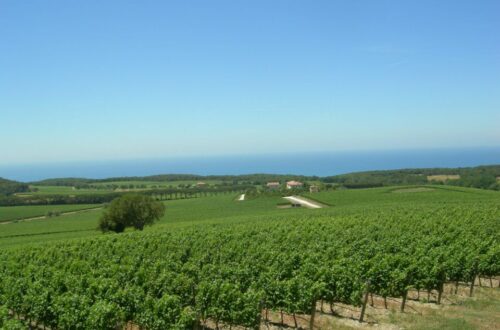Table of Contents
What Is Casavecchia di Pontelatone DOC Wine?
Casavecchia di Pontelatone DOC represents one of Italy’s rarest and most exclusive wine appellations, producing fewer than 900 cases annually from ancient indigenous vines in Campania’s volcanic hills. Officially recognized in 2011, this remarkable DOC showcases the rediscovery of the Casavecchia grape, once nearly extinct, now crafting some of southern Italy’s most distinctive and age-worthy red wines from mineral-rich soils near Naples.
History: From Forgotten Vine to DOC Recognition
The story begins in the late 19th century, when local farmer Scirocco Prisco noticed a single thriving vine growing by an old ruin in Pontelatone. Locals called it “l’uva e chella casa vecchia” (“the grape of the old house”), which gave birth to the grape’s modern name: Casavecchia.
For decades, Casavecchia remained a hidden treasure until the official DOC recognition in 2011, solidifying its place among Campania’s prestigious wines.
Casavecchia Wine Region Geography and Volcanic Terroir
The DOC covers hillside vineyards across Caserta province, including Liberi, Formicola, Pontelatone, Caiazzo, Castel di Sasso, Castel Campagnano, Piana di Monte Verna, and Ruviano.
Here, the terroir is profoundly volcanic—soils of clay, limestone, and tuff yield wines with a signature earth-mineral backbone. The Mediterranean climate, averaging 15.2 °C with 1,153 mm of rainfall annually, balances ripeness with freshness, shaping wines that age gracefully.
Casavecchia Grape: Campania’s Ancient Indigenous Variety
The DOC requires wines to be at least 85% Casavecchia, with up to 15% permitted from other non-aromatic red grapes of Campania.
Casavecchia is low-yielding, rare, and almost exclusively grown in this microzone—making it a prime example of Italy’s indigenous grape revival movement.
Wine Styles and DOC Production Regulations
- Rosso: Min. 12.5% alcohol; 2 years aging (1 in wood).
- Riserva: Min. 13% alcohol; 3 years aging (18 months in wood).
Only about 10 hectares are under vine, yielding ~900 cases per year—a scale that places Casavecchia among Italy’s most collectible wines.
Casavecchia Wine Tasting Notes and Characteristics
Expect deep ruby color, firm tannins, and aromas of black cherry, plum, herbs, leather, and volcanic minerality.
- Younger wines: bright fruit, rustic tannins.
- Aged Riservas: layered spice, earth, and elegant structure with notable longevity.
Best Casavecchia Producers and Where to Buy
- Alois Winery – Known for Trifolium and Trebulanum Riserva, Alois is the standard-bearer for Casavecchia. Their Riservas are structured, collectible wines.
- Producers to Watch: Viticoltori in Pontelatone and boutique growers experimenting with organic practices.
- Where to Buy: Specialty importers in the US and UK, Italian-focused wine merchants, and curated online retailers like Wine-Searcher often list limited allocations.
- Pricing: Typically €25–€50 for Rosso; €60–€90+ for Riserva bottlings, reflecting their rarity and aging potential.
Food Pairing Guide for Casavecchia Wine
Casavecchia’s bold character makes it ideal with Campania’s hearty cuisine:
- Meat pairings: wild boar ragu, roasted lamb, grilled beef.
- Cheese pairings: aged caciocavallo, pecorino.
- Local match: La Genovese Napoletana (slow-cooked onion and beef sauce) is a sublime partner.
Visiting Casavecchia Wineries in Campania
Wine tourism in Caserta is intimate and rewarding. Visitors can tour family-run vineyards in Pontelatone, taste alongside producers, and pair Casavecchia wines with local specialties like mozzarella di bufala, slow-cooked meats, and rustic breads. The area is easily reached from Naples—making it a compelling detour for wine travelers exploring southern Italy.
Investment & Collectibility
Because of its extreme rarity (900 cases annually) and strong aging potential, Casavecchia wines appeal to collectors of Italian rarities. As volcanic terroir wines gain global interest, Casavecchia’s profile is likely to rise, making early investment both culturally and financially rewarding.
FAQ on Casavecchia di Pontelatone DOC
Q: How much does Casavecchia wine cost?
Typically €25–€50 for Rosso; €60–€90+ for Riserva bottlings.
Q: What does Casavecchia wine taste like?
Structured and bold, with black fruit, spice, leather, and volcanic minerality.
Q: Is Casavecchia worth collecting?
Yes. With tiny production and strong aging capacity, it is among Italy’s most collectible wines.
Q: Where can I buy Casavecchia di Pontelatone wine?
Boutique importers, specialty Italian merchants, and platforms like Wine-Searcher.
Q: How to pronounce Casavecchia?
“Kah-za-VEK-kee-ah.”
Q: Best vintages?
2015 and 2018 are particularly praised; Riservas age beautifully.
Q: Can you visit Casavecchia wineries?
Yes—many small producers in Pontelatone and Caserta welcome visitors.
Fun Facts & Cultural Notes
- Name origin: “Casavecchia” means “old house,” from the ruin where it was rediscovered.
- Micro-appellation: At just 10 hectares, it’s one of Italy’s smallest DOCs.
- Volcanic kinship: Shares terroir magic with Taurasi and Lacryma Christi, yet remains far rarer.
Call-to-Action for Audience Engagement
Discover more of Italy’s hidden wine treasures through Drink Italian. Join our community for insider guides to rare DOCs, stories of indigenous grapes, and curated tasting experiences that connect you with Italy’s most authentic wines.


